Main Body
4 Communicating with Leadership Congruence
Herb L. Thompson III
INTRODUCTION
Let’s take a moment to pause and consider what we have learned to this point. Chapter 1 focused on self-awareness and the importance of evaluating our view of ourselves. Chapter 2 focused on defining personal values, which we now know play a vital role in leadership practice. Chapter 3 defined vision and provided a framework for goal-setting. Each of these chapters was intended to introduce you to the Social Change Model (SCM) of Leadership and the ways we can practice it. This chapter seeks to build upon the previous chapters in preparing you to communicate your self-awareness, values, and goals to others. This is the chapter where we move from internal awareness to external action as we seek to share who we are with others congruently. The geometric principle of congruence can illustrate the way we might incorporate the SCM concept of congruence into our leadership practice. In geometry, two triangles that reflect the same size and angles are considered to be congruent, regardless of their orientation in space. I think it is helpful to have a visual of this (see Figure 1).
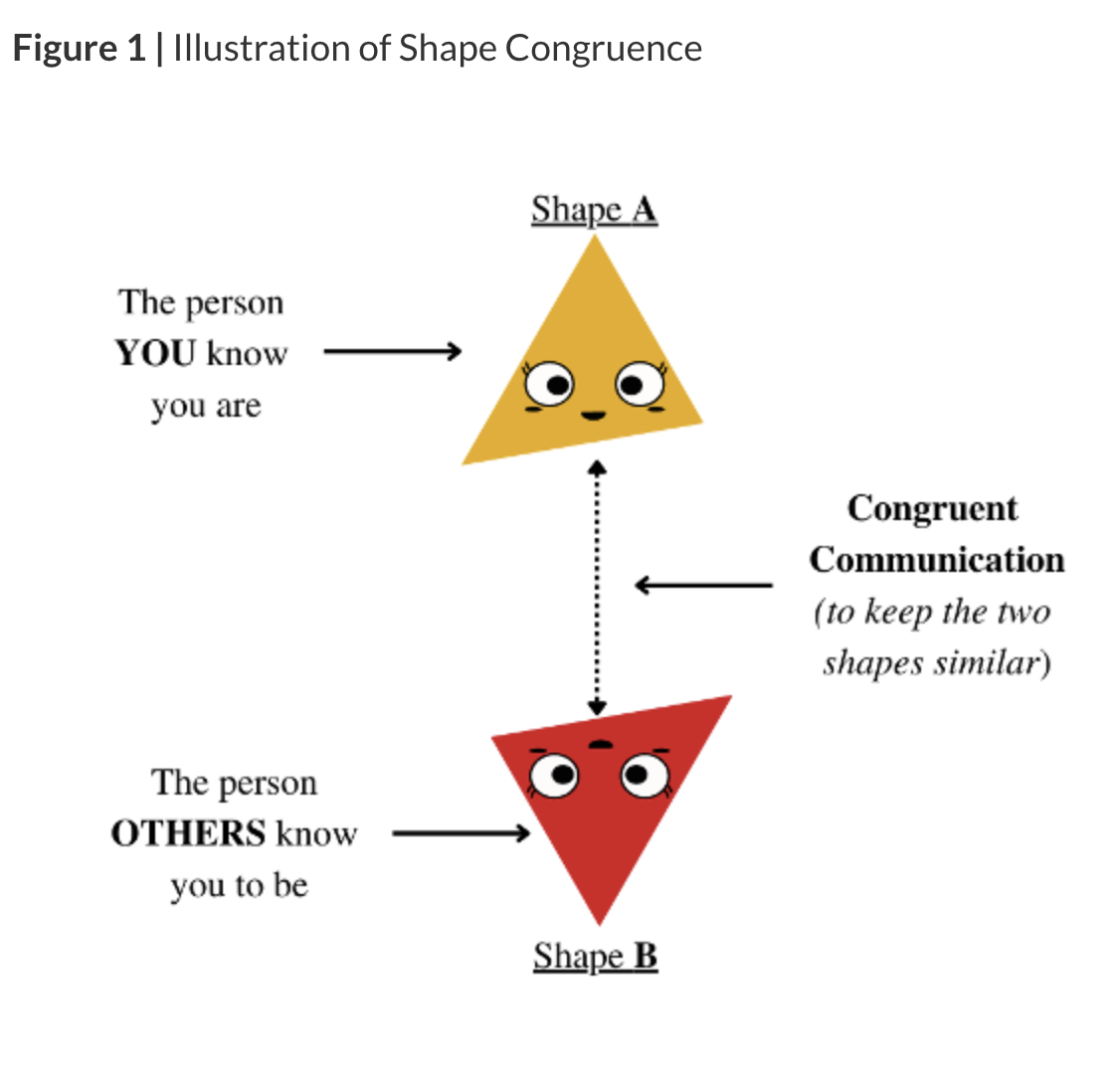
The concept of congruence in the Social Change Model of Leadership (SCM) reflects this geometric principle in suggesting that leaders ought to act toward others in ways that are consistent, genuine, authentic, and honest with their inner selves (Higher Education Research Institute, 1996, p. 36). Though the shapes A and B (Figure 1) may look incongruent, any perception of difference can be explained by our perspective based on how they are oriented in space. The true shape of our identity will always be significantly more complex than what we can possibly explain or communicate to others. Even so, if we value the leadership principle of congruence, we can strive to make our interactions with others line up congruently with our true identity and values.
Join me on a reflective journey back in time to your first experience with geometry. It was this subject that let us explore shapes and their possible arrangements. When I think back to those experiences with shapes and figures, I remember how fun it was to discover that two shapes could be congruent regardless of our perspective of their shape. Take Figure 1, for example. It shows two figures that may seem different, but when applying the geometric principle of congruence, we learn that these shapes are more alike than dissimilar. Shape A and shape B, though appearing to be different based on perspective, can be said to be congruent because they truly are identical in angle and size. What a fitting analogy for the principle of leadership congruence we will engage with in this chapter. As we grow in our understanding of ourselves (self-consciousness, from Chapter 2), we strive to effectively and authentically communicate our true identity to others. It should be noted that it is not possible for any one person to completely know any other person. Even so, if we are intentional in our communication with others, we might be able to help them know us in ways that bear congruence with our true motives, values, and identity. When we practice congruent communication, we are working to ensure that shapes A and B maintain consistent congruence no matter the depth of knowledge that person may have of us in that given moment.
Many strive to have the type of life balance where internal values and principles can be understood and appreciated by those around us. Imagine a world where you could accurately represent yourself to others in a way that is authentic and valuable to others. The prospect of being able to live, work, and grow in a community that you understand and that understands you is appealing to possibly all of us, and why not? That type of household, workplace, or community is one where people can be accepted and appreciated consistently, and most of us (if not all of us) truly desire that. This chapter introduces a conversation on how we might experience that type of clarity with our community and how we might lead others to experience it too.
According to the Social Change Model (SCM), congruency is an important component in an individual’s leadership development (Higher Education Research Institute, 1996). Congruence can be explained as an alignment between our thinking, feeling, and actions so that we can represent ourselves to others honestly and genuinely (Shalka, 2016). Communication is the primary way people come to understand us and perceive us (Wood, 2018). If our aim is to be perceived as effective leaders, it benefits us to 1) understand ourselves and 2) develop our personal communication skills so others can perceive us as clear and dependable (Higher Education Research Institute, 1996). The concept of congruence is critical in this process (Edwards & Cable, 2009). Congruence is defined as “Thinking, feeling, and behaving with consistency, genuineness, authenticity, and honesty towards others; actions are consistent with most deeply-held beliefs and convictions; interdependent with Consciousness of Self” (Higher Education Research Institute, 1996). Figure 2 depicts this concept, demonstrating how our internal world impacts our leadership influence.
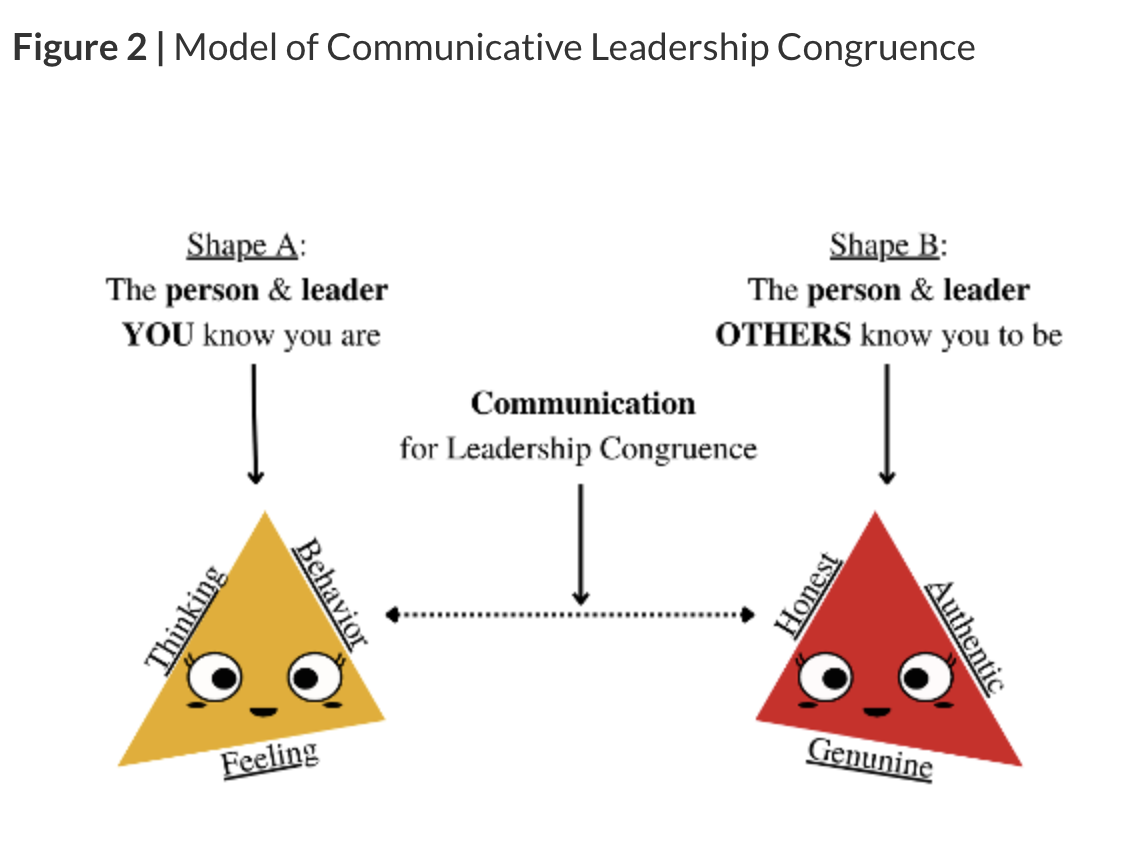
We cannot expect to be perceived as congruent unless others see and hear messages from us that are honest, genuine, and authentic. This chapter builds upon the previous chapters and points to coming chapters by examining how we take our internal world and communicate it to others in congruent and effective ways.
CHAPTER OBJECTIVES
By the end of this chapter, you will be able to…
- develop a congruent communication plan that builds from your personal identity, values, and goals.
- practice communicating your self-authorship congruently through messages in a professional context.
KEYWORDS: Congruency, communication, self-authorship
Before we begin, let’s define those keywords that will help orient you to the content of this chapter.
- Congruency: “Thinking, feeling, and behaving with consistency, genuineness, authenticity, and honesty towards others; actions are consistent with most deeply-held beliefs and convictions; interdependent with Consciousness of Self” (Higher Education Research Institute, 1996).
- Communication: “Communication is a systematic process in which people interact with and through symbols to create and interpret meanings” (Wood, 2018).
- Self-authorship: “self-authorship represents our capacity to take in information from our environments, put that information through the filter of our own values and beliefs, and then use that process to make meaning of our world in ways that are connected to our unique internal voice” (Shalka, 2016, p. 71).
This chapter aims to prepare you, a developing leader, to communicate congruently. To start, we will define congruency, as this is a critical aspect of leadership in the Social Change Model (Higher Education Research Institute, 1996). Secondly, we will explore the role communication plays in congruent leadership (Shalka, 2016). Finally, we will outline some target areas for effective, congruent communication.
Congruency and Leadership
It has been said that congruence is critical to effective leadership (Higher Education Research Institute, 1996). The role that congruence serves for our leadership can be compared to the role gravity plays in our existence here on planet earth. Our existence on earth depends on the active presence of gravity and its outcomes. Gravity, in a practical sense, affords us 1) a foundation to walk on, 2) stability as we walk, 3) predictability for how we will walk in the future, and 4) trust that we will always walk this same way. Congruence, like gravity, serves to ground us, stabilize us, familiarize us, and build trust.
- Congruence grounds us in our values which provide a foundation for action.
- Congruence provides stability for feelings that can be subject to whim and rapid change: congruence informs how we react to feelings and communicate them.
- Congruence allows others to predict how we will act, which is no small matter for those who are following you.
- Congruence is predicated on trust: trust that those around you have in you to behave consistently from situation to situation.
The importance of congruence should not be overlooked. A study by Porras and Colleagues (2007) identified that long-term success for leaders occurred when they “could identify what was personally meaningful to them and then pursue it” (Shalka, 2016, p. 69). It seems that congruence plays an important role in leadership when change is necessary. Research has shown that effective leaders employ their influence on issues that are important to them (Porras et al., 2007). Congruent leaders are individuals who have clear alignment between their personal values and their leadership actions. These leaders can lead extraordinary change in organizations, communities, and beyond.
Congruence begins with self-awareness which we covered in Chapter 1 of this book. In a practice of self-consciousness, let’s take a few moments to reflect. In a journal or on a spare piece of paper, jot down your initial thoughts to the questions below. These are intended to provide you with some thoughts and language that we will utilize in a later activity.
Questions from HERI (Higher Education Research Institute, 1996, p. 36):
- Who are you as an individual?
- How are you alike and different from your family and your peer group?
- What are the boundaries of your individuality?
- How does it feel when you act incongruently (e.g., when your behavior is inconsistent with your beliefs and values)?
- Does your behavior really reflect your true self and your innermost values, or are you merely playing a role or exhibiting a facade?
- What are the authentic truths of your life?
- When you act in ways contrary to your core values and what you truly think, feel, or believe, how does this affect your feelings of wholeness and authenticity?
These responses are intended for you to identify your shape A (Figure 1) and to better identify how you can communicate congruently. Your answers do not need to be shared in this more raw form, but they will be helpful when developing your congruent communication plan at the end of the chapter. These reflection answers, along with your list of personal values from Chapter 2, provide you with elements of self-awareness that you can act upon and communicate to others. Returning to Figure 2, which represents the elements of congruence, we must ask how we translate our internal values into external action. We can use Figure 3 to respond to this question by illustrating the critical role communication plays in the practice of leadership congruence.
Figure 3 | Visualization of Communicated Congruence
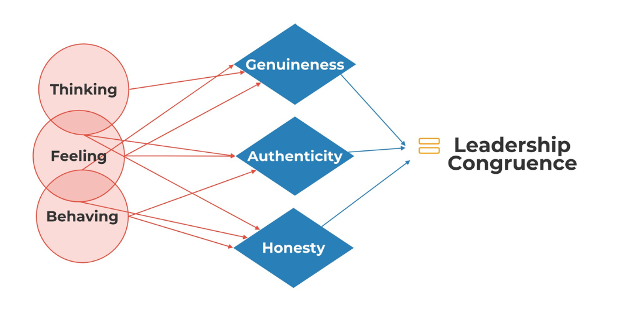
To review, the practice of leadership congruency provides us and others with 1) a foundation for authentic behavior, 2) stable communication expectations, 3) clarity in communication norms, and 4) shared trust-building. This “gravity” of congruency is increasingly valuable when we engage in leadership behavior. When we lead and communicate congruently, we provide our audience with the information they need when deciding whether they will follow our lead. Our efforts in leadership will benefit from some “gravity” to guide our influence relationships with others. The following section explains this communication connection in more detail.
Congruency and Communication
By this point, it is clear congruence involves an alignment of our internal values with our external actions and communication. The concept of self-authorship can further explain how communication helps us align our leadership congruently.
As a reminder, self-authorship “represents our capacity to take in information from our environments, put that information through the filter of our own values and beliefs, and then use that process to make meaning of our world in ways that are connected to our unique internal voice.” (Shalka, 2016, p. 71)
Self-authorship is a helpful concept to consider because it identifies a process we all engage in, and it can also become a helpful beginning point for messages we send to those around us. As we grow in our self-awareness, we can then exercise self-authorship to share our values, beliefs, and meaning through a voice of our own. There are three dimensions of self-authorship, provided in Table 1, along with related questions and suggestions to help you reflect. These dimensions of self-authorship are helpful to consider when seeking to align our internal values, beliefs, thoughts, and emotions with our interactions and leadership actions. Self-authorship has been found to help individuals “take in all the information of their surroundings and make meaning of it in ways that are internally derived” (Shalka, 2016, p. 72).
Table 1 | Dimensions of Self-Authorship
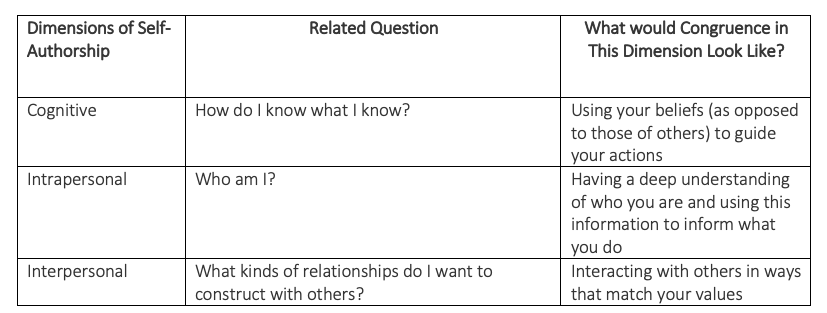
Self-authorship is a process we already enact, but it can be more useful to us when we choose to employ it with intentionality. Communication once again offers us a way to congruently represent our internal self-authorship processes and experiences to those around us and those we lead.
Wood (2018) defines communication as “a systematic process in which people interact with and through symbols to create and interpret meanings” (p.77). Like self-authorship, communication is a process focused on meaning-making. Unlike self-authorship, which is primarily focused on ourselves, communication focuses on the audience and the actions we take to share our perspective with them so they can find a similar meaning (Wood, 2018). Effective communicators are able to express their Shape A (inner selves) to others honestly, genuinely, and authentically. They are able to do this because they prioritize the people/audience they are communicating with. When we communicate with others, we take our internal perspective, we encode our meaning into messages, then we attempt to share that message with others in the hopes that they decode the same meaning we intended to send. The difference between effective communication and ineffective communication is decided by our ability to transfer our meaning/messages in a way our audience can interpret clearly. As we seek to align our internal world with our actions and interactions toward the outer world, it is important to prioritize our audience because it is their interpretation of our communication that matters most.
Wood (2018) also states that the “self” arises when we communicate with others, further emphasizing the importance communication plays in the self-authorship process. Are there times you can think of when you came to understand yourself better as you were communicating your thoughts and experience with others? Can you recall moments when you became more confident in your identity as you communicated it clearly to others? For this author, a memory of an interview comes to mind where I was asked to list my personal strengths. Like any good job applicant (which I was, in this memory), I rehearsed this question a dozen times, and I felt prepared to answer.
Interestingly, though, my answer and the confidence with which I said it drove a point home for me even more than the interviewer. I left that interview knowing that the strengths I listed were more than words; they were a confirmed part of my identity from that moment on. That interview confirmed for me that the self does, in fact, arise when we communicate with others. This further increases the importance communication plays in our self-authorship and our interaction with those around us.
Communication is a vast and far-reaching field, discipline, and practice. It is not practical to think that any one book could fully address its importance, its principles, and associated skills. In this section, we will focus our attention on communication skills that connect with the internal process of self-authorship. Relational transparency is a helpful concept that comes from the theory of authentic leadership (Northouse, 2019; Gardner et al., 2005; Avolio et al., 2009). Relational transparency is defined as “self-disclosure comprised of an expression of any or all of four aspects of self-disclosure: goals/motives, identity, values, and emotions (G-I-V-E)” (Hughes, 2005, p. 84). Relational transparency is helpful for our purposes because it provides four clear categories of self-disclosure that can help us to relay our experiences of self-authorship to the people around us. Table 2 explains each element of G-I-V-E and provides an example of how each area might be employed. It should be noted that each area of this communication is dependent on the ability of the communicator/leader to accurately 1) self-author experiences and 2) encode the message for their audience.
Table 2 | G-I-V-E Communication
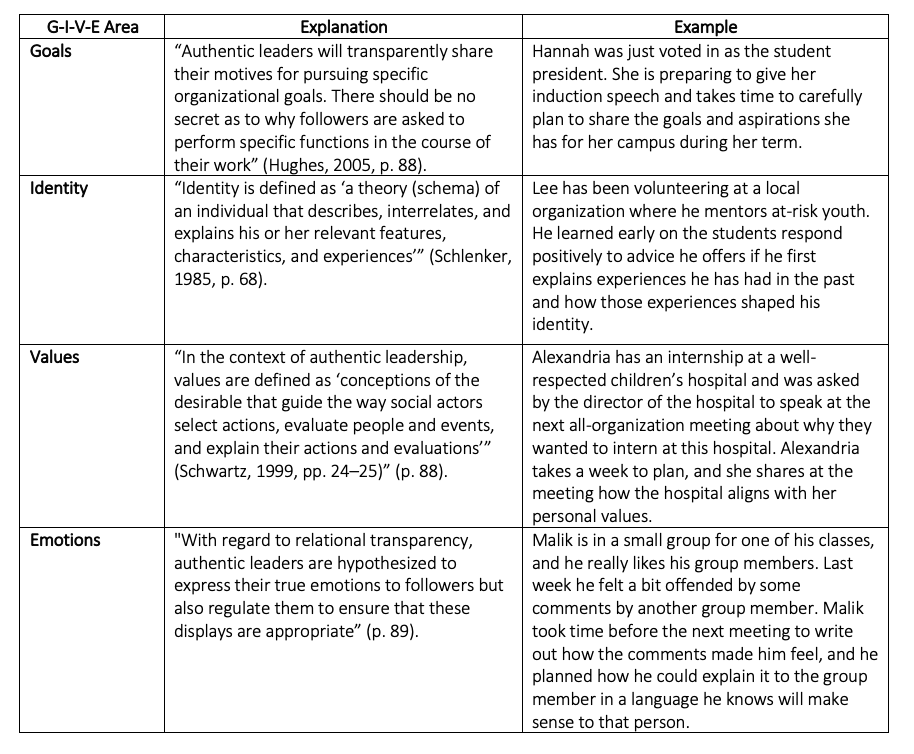
Congruence requires communication, and only our audience can determine if we have effectively shared our meaning with them in a congruent fashion. Congruent communication matters in present situations and future ones. We want to communicate congruently with our teachers so they can know us better and help us grow more intentionally. We want to communicate with our friends congruently so they can truly know us and so we can know them truly. We learn to communicate with our family and loved ones so our shared trust can mature. We will benefit in future goals because our congruent communication will give others clarity about our goals and our motives. In the next section, we will focus on how we can develop an effective plan for congruent communication.
ACTIVITY
Congruent Communication Plan
This activity positions us to transfer our self-authorship into effective communication through an intentional plan. At the end of this section, you will develop a congruent communication plan consistent with a popular, professionally-oriented social media platform. Wood (2018) provides three arenas of life where communication occurs: personal life, professional life, and civic life. This activity focuses on the professional arena and requires you to provide context-appropriate messages about your personal 1) goals, 2) identity, 3) values, and 4) emotions. This exercise provides targeted areas for you to develop honest, genuine, and authentic messages that explain who you are in a clear and congruent fashion. You will develop intentional messages for a professional social profile that congruently connects your values and identity through intentional messages that should be appropriate for the academic/professional context. The objective of this exercise is to practice connecting your self-authorship process with intentional communication processes so you can share your identity with others congruently. This exercise provides four profile categories and specific directions on how you might develop strategic messages that reveal your true self to others congruently.
DIRECTIONS: This activity is meant to prepare you to communicate who you are to others so their understanding of you is congruent with your true self (shape A in Figure 1). We are using a social media example because, in modern times, this is a regular source for communicating our identity to others. Gather your Values Activity results from Chapter 2 (Defining My Personal Values) and your answers to the questions about self-authorship in Table 1 of this chapter. These will prove useful as you create your congruent communication plan. Follow the steps provided below using the diagram that follows.
STEP 1 (Goals Section): In the attached worksheet, you will find a section labeled “About Me & Goals.” Professional profiles usually include a section where you share a summary line or two about your professional identity. This is a great opportunity to share your aspirations, motivations, and goals. In that section on the assignment sheet, use 3-5 sentences to introduce yourself in a way that highlights your personal goals and motivation. It is important to be honest, genuine, and authentic, and be sure you consider language that will be clear and helpful to your audience.
STEP 2 (Identity Section): Professional profiles provide a variety of ways for you to express your identity directly and indirectly. In this section, you will share your 1) name, 2) pronouns (if you choose to share those), 3) headline statement, 4) profile picture, and, 5) banner picture. Fill in this section with 1) your name as you want it to be used professionally, 2) a headline statement that expresses something about your identity clearly and appropriately, and 3) a profile picture and a banner picture that represent you congruently (honestly, genuinely, authentically). If you are not able to insert pictures in the document, feel free to write a description of the images you would use.
STEP 3 (Values or Groups Section): Professional profiles are helpful for this exercise because they provide unique ways for us to share our values with our audience directly and indirectly. Some platforms provide you the option to follow organizations which will then appear in your feed on a regular basis. This can be considered another avenue for us to communicate our values to others. When we socially or professionally “follow” organizations, we are communicating to others our values and standards. In this section, use your top values to identify three organizations that are congruent with you. To complete this section, you simply need to 1) provide the name of each organization you choose to follow, 2) explain in 1-2 sentences why that organization aligns with your personal values, and 3) explain in 1-2 sentences what you believe others will think if they see you associate with this organization.
STEP 4 (Emotions Section): Almost all social and professional profiles provide an option for you to share your thoughts and opinions with others. This common social media practice is helpful when considering how we communicate our emotions with others appropriately and congruently. For this section, you will create a post that represents an appropriate disclosure that could populate your profile feed. Focus your message toward demonstrating your congruency and leadership in everyday situations and being honest about something important in your current life (e.g., a promotion, an accomplishment, a goal, etc.).
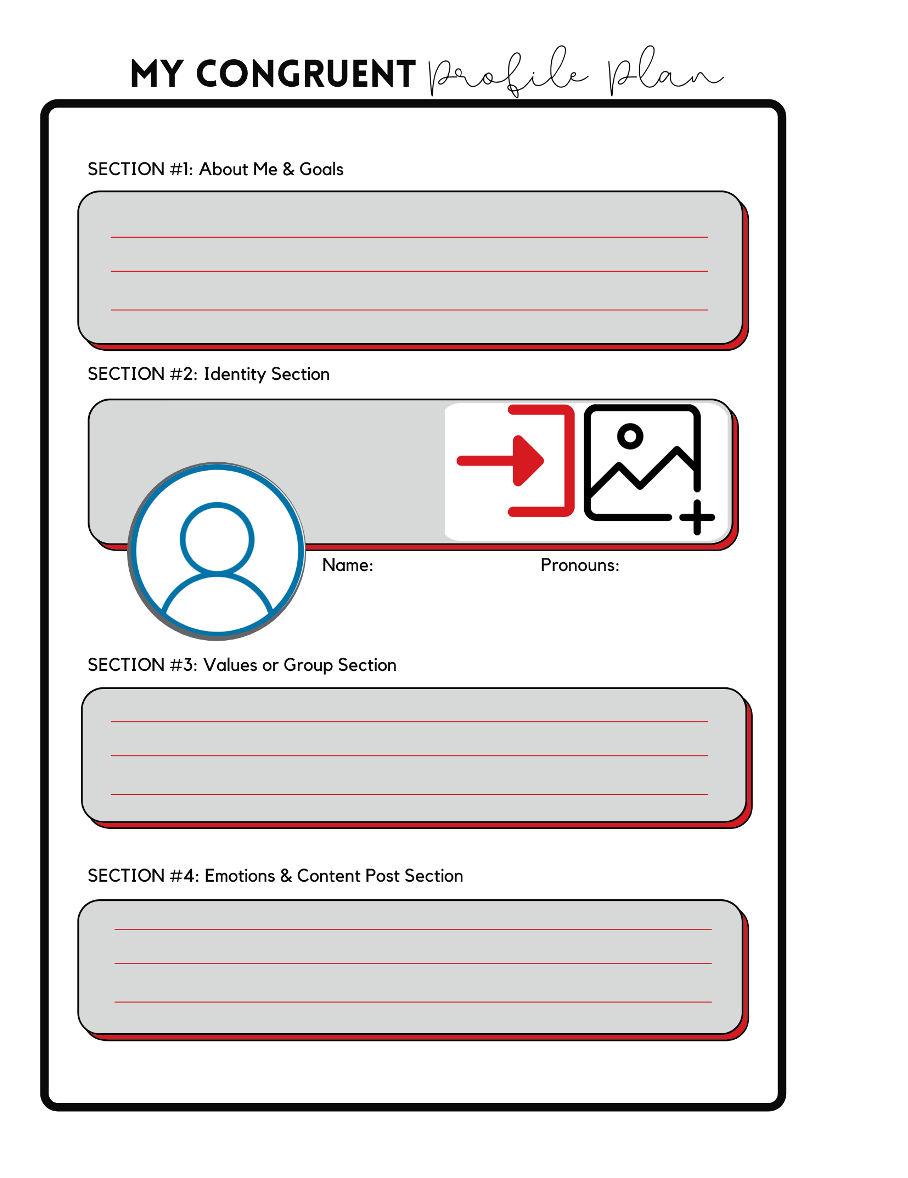
REFERENCES
Avolio, B. J., Walumbwa, F. O., & Weber, T. J. (2009). Leadership: Current theories, research, and future directions. Annual Review of Psychology, 60, 421–449. https://doi.org/10.1146/annurev.psych.60.110707.163621
Edwards, J. R., & Cable, D. M. (2009). The value of value congruence. Journal of applied psychology, 94(3), 654–677. https://doi.org/10.1037/a0014891
Gardner, W. L., Avolio, B. J., Luthans., May, D. R., & Walumbwa, F. (2005). “Can you see the real me?” A self-based model of authentic leader and follower development. The leadership quarterly, 16(3), 343–372. https://doi.org/10.1016/j.leaqua.2005.03.003
Higher Education Research Institute. (1996). A Social Change Model of Leadership Development (Version III). UCLA. https://www.heri.ucla.edu/PDFs/pubs/ASocialChangeModelofLeadershipDevelopment.pdf
Hughes, L. W. (2005). Developing transparent relationships through humor in the authentic leader-follower relationship. Authentic leadership theory and practice: Origins, effects, and development, 3, 83–106.
Northouse, P. G. (2019). Introduction to leadership: Concepts and practice. Sage Publications.
Porras, J., Emery, S., & Thompson, M. (2007). Success built to last: Creating a life that matters. Wharton School Publishing.
Schwartz, S. H. (1999). A theory of cultural values and some implications for work. Applied Psychology: An International Review, 48(1), 23–47. https://doi.org/10.1111/j.1464-0597.1999.tb00047.x
Shalka, T. R. (2016). Congruence. In Komives, S. R., & Wagner, W. (Eds.). (2016). Leadership for a better world: Understanding the Social Change Model of Leadership Development. (pp. 66–86). [eBook edition]. John Wiley & Sons.
Wood, J. T. (2018). Communication mosaics: An introduction to the field of communication. Cengage Learning.

